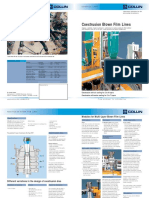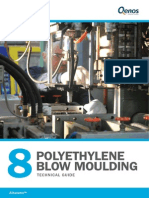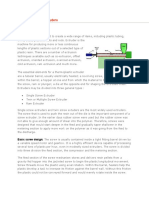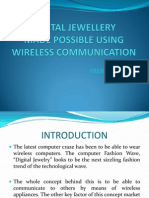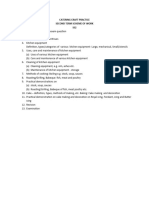Film
Film
Uploaded by
Dhileepan KumarasamyCopyright:
Available Formats
Film
Film
Uploaded by
Dhileepan KumarasamyOriginal Description:
Copyright
Available Formats
Share this document
Did you find this document useful?
Is this content inappropriate?
Copyright:
Available Formats
Film
Film
Uploaded by
Dhileepan KumarasamyCopyright:
Available Formats
FILM BLOW ING
Plastic melt is extruded through an annular slit die, usually vertically, to form a thin walled tube. Air is introduced via a hole in the centre of the die to blow up the tube like a balloon. Mounted on top of the die, a high-speed air ring blows onto the hot film to cool it. The tube of film then continues upwards, continually cooling, until it passes through nip rolls where the tube is flattened to create what is known as a ' lay-flat' tube of film. This lay-flat or collapsed tube is then taken back down the extrusion ' tower' via more rollers. On higher output lines, the air inside the bubble is also exchanged. This is known as IBS (Internal Bubble Cooling).
The lay-flat film is then either kept as such or the edges of the lay-flat are slit off to produce two flat film sheets and wound up onto reels. If kept as lay-flat, the tube of film is made into bags by sealing across the width of film and cutting or perforating to make each bag. This is done either in line with the blown film process or at a later stage.
Typically, the expansion ratio between die and blown tube of film would be 1.5 to 4 times the die diameter. The drawdown between the melt wall thickness and the cooled film thickness occurs in both radial and longitudinal directions and is easily controlled by changing the volume of air inside the bubble and by altering the haul off speed. This gives blown film a better balance of properties than traditional cast or extruded film which is drawn down along the extrusion direction only.
blown film extrusion Blown Film Extrusion is a common polymer manufacturing process used to make grocery bags, garbage bags, and even such products as scientific balloons (1). Advantages of blown film extrusion include the ability to produce tubing in a single process, high productivity, and the capability to produce biaxial oriented parts. Disadvantages of the process include low tolerances, low-efficiency cooling, and at times low optical properties when compared to cast film.
The blown film lines (blown film extrusion) process is simple compared to processes such as injection molding. The process begins with plastic in pellet form that is dropped into an extruder from the hopper. The extruder conveys the plastic forward using a rotating screw. The screw melts the plastic by both friction and outside heaters around the barrel. Once the plastic is molten the plastic is fed upwards through a circular die to form a hollow plastic tube filled with a desired amount of air. The plastic tube is continuously brought upward from the tensile force (pull) of nip rollers above the die. The nip rollers are two wheels like steam rollers which are several feet above the die. The nip rollers are pressured together to form a pinch off on the bubble, keeping a constant air volume below and flattening the plastic out. Generally the flat plastic is fed through take off rollers as it cools and finally fed into a machine for cutting.
In thermoforming, a sheet of plastic is used to cover a shape (e.g. a die) by heating the sheet till it is semifluid, and then pulling it over the die using vacuum suction (this method is called vacuum forming). In an alternate form, called pressure forming, the pressure is applied using high pressure air from above the plastic sheet. This process is most commonly seen in packaging of food, toys etc.; it is also used to make appliance housings, etc. The following schematic shows different types of thermoforming. (a) plastic sheet loaded into frame(b) frame slides out above mold(c) heated mold is raised, forming convex shapes(d) vacuum lines pull the plastic into concave holes(e) frame returns to reload; mold lowered; part removed
You might also like
- Injection Blow MoldingDocument2 pagesInjection Blow MoldingDeaNo ratings yet
- JOH CLOUTH - Safe Practice For The Handling of Doctor BladesDocument24 pagesJOH CLOUTH - Safe Practice For The Handling of Doctor Bladesgustirizkiawan100% (1)
- How To Solve Blow Molding ProblemsDocument12 pagesHow To Solve Blow Molding ProblemsOmar EstradaNo ratings yet
- Extrusion Blown FilmDocument51 pagesExtrusion Blown Filmmani zendedel100% (3)
- Clase 7. Blown Film ExtrusionDocument37 pagesClase 7. Blown Film ExtrusionJuan Carlos Amaro ReyesNo ratings yet
- Blown FilmDocument4 pagesBlown Filmwahyutrisutrisno910% (1)
- Processing of Plastics PDFDocument61 pagesProcessing of Plastics PDFCh Talha0% (1)
- Blown Film ExtrusionDocument3 pagesBlown Film Extrusionchoirunissa setyaningrumNo ratings yet
- Blown FilmDocument18 pagesBlown Filmahsan888100% (2)
- Topics Covered: Processing of PlasticsDocument30 pagesTopics Covered: Processing of PlasticsParthiban DhakshnamurthyNo ratings yet
- Blown FilmDocument11 pagesBlown FilmMarc Romero100% (1)
- Blown Film CoexDocument4 pagesBlown Film CoexTaeng SoshiNo ratings yet
- Film ExtrusionDocument16 pagesFilm ExtrusionhatharasingheNo ratings yet
- Film Coextrusion Troubleshooting 7832Document28 pagesFilm Coextrusion Troubleshooting 7832Almir MachadoNo ratings yet
- The Tubular Film Blowing ProcessDocument9 pagesThe Tubular Film Blowing ProcessAlmir MachadoNo ratings yet
- Report BengkelDocument11 pagesReport BengkelMuhammad Nasri Zainal AbidinNo ratings yet
- What Is Blown Film ExtrusionDocument2 pagesWhat Is Blown Film ExtrusionJonas BonfimNo ratings yet
- Extrusion Moulding Process PDFDocument2 pagesExtrusion Moulding Process PDFKim100% (1)
- PFF of Blown Film Process FromDocument32 pagesPFF of Blown Film Process FromMark Stern100% (1)
- Design of Extrusion HeadsDocument64 pagesDesign of Extrusion HeadsMohamed HassanNo ratings yet
- Blow Moulding MachineDocument114 pagesBlow Moulding MachineAbdelmoneim NoohNo ratings yet
- Optomizing Corona TreatmentDocument10 pagesOptomizing Corona TreatmentTito Setiawan NugrohoNo ratings yet
- Blown Film ProblemsDocument33 pagesBlown Film ProblemsNoel AndradeNo ratings yet
- Blown Film Bubble Stability ProblemsDocument6 pagesBlown Film Bubble Stability ProblemsAhsan Ikram100% (1)
- Celanex, Vandar, Impet and Riteflex: Thermoplastic PolyestersDocument51 pagesCelanex, Vandar, Impet and Riteflex: Thermoplastic PolyestersAnselmo_De_Oli_1266No ratings yet
- How Are Bottles MadeDocument3 pagesHow Are Bottles Madelumineur0% (1)
- Injection Mould Design For PVCDocument7 pagesInjection Mould Design For PVCbile_taseNo ratings yet
- Injection Molding Machine SnopsisDocument6 pagesInjection Molding Machine Snopsisrajinder kutaalNo ratings yet
- TG BlowDocument67 pagesTG BlowVikas Singh100% (3)
- Arburg370&420C PDFDocument8 pagesArburg370&420C PDFMatoa Papeda0% (1)
- Blow Molding Handbook (Print-on-Demand)Document21 pagesBlow Molding Handbook (Print-on-Demand)RaynerNo ratings yet
- 2 1 ExtrusionDocument69 pages2 1 ExtrusionSingh Anuj0% (1)
- Blow Molding Machine ProcessDocument4 pagesBlow Molding Machine Processuocmogiandi_a100% (1)
- Blown Film TrableDocument2 pagesBlown Film TrableNavin Ramadas100% (1)
- Plastics Processing TechniquesDocument59 pagesPlastics Processing TechniquesSusmit NimjeNo ratings yet
- Injection Blow Molding (IBM) :: Is Used ForDocument2 pagesInjection Blow Molding (IBM) :: Is Used ForErickNo ratings yet
- Lecture 9-Blow Molding PDFDocument24 pagesLecture 9-Blow Molding PDFAhmed WaelNo ratings yet
- Blown Film CatalogueDocument12 pagesBlown Film CatalogueMohammad-reza NabavinezhadNo ratings yet
- Types of Plastic ExtrudersDocument7 pagesTypes of Plastic ExtrudershvadnalaNo ratings yet
- Plastic Injection Molding PDFDocument36 pagesPlastic Injection Molding PDFkamelNo ratings yet
- Blown Film Lines BrochureDocument20 pagesBlown Film Lines BrochureOsmar JrNo ratings yet
- BM1 ProcessDocument55 pagesBM1 Processeduardo_umNo ratings yet
- Formulas PDFDocument1 pageFormulas PDFAnonymous 9BCHn5EX100% (1)
- Injection Blow MouldingDocument22 pagesInjection Blow MouldingPRANJAL KUMARNo ratings yet
- Inj Moulding of Thermoset MaterialsDocument3 pagesInj Moulding of Thermoset MaterialsvinayakNo ratings yet
- Exrusion 1Document41 pagesExrusion 1UsMan ZaFarNo ratings yet
- Doctorblademetering 140522064831 Phpapp02Document48 pagesDoctorblademetering 140522064831 Phpapp02rafael_faria_4No ratings yet
- Flat Film Forming: Andrew Leithead Chris Barr Nick AntonakosDocument32 pagesFlat Film Forming: Andrew Leithead Chris Barr Nick AntonakosHOANGVUNL1988No ratings yet
- Extrusion Blow MouldingDocument13 pagesExtrusion Blow Mouldingkish007rdNo ratings yet
- Extruder Tutorial PDFDocument314 pagesExtruder Tutorial PDFAntonius PrakosaNo ratings yet
- ASB Blow MoldingDocument52 pagesASB Blow MoldingManuelCaballeroNo ratings yet
- Micro Injection Molding Machine-ANN TONG INDUSTRIAL CODocument4 pagesMicro Injection Molding Machine-ANN TONG INDUSTRIAL COAndreas AlvaroNo ratings yet
- RIL BoppDocument14 pagesRIL BoppSaurabh PariharNo ratings yet
- Ultimate Plasticating Screw - Updated 3.2023Document9 pagesUltimate Plasticating Screw - Updated 3.2023ពេជ្រ សុវណ្ណចន្ទ័គិរីNo ratings yet
- Blown Film TroubleshootingDocument1 pageBlown Film TroubleshootingMiguelAngelPerezEsparzaNo ratings yet
- Blown Film ExtrusionDocument1 pageBlown Film ExtrusionDhanush ANo ratings yet
- ExtrusionDocument19 pagesExtrusionKlea Camille Ganoy Briones100% (1)
- Extrusion Blow MoldingDocument23 pagesExtrusion Blow MoldingBeshoy NadyNo ratings yet
- 108 Amman Pottri PDF DownloadDocument4 pages108 Amman Pottri PDF DownloadDhileepan Kumarasamy100% (1)
- Department of Mechanical EngineeringDocument2 pagesDepartment of Mechanical EngineeringDhileepan KumarasamyNo ratings yet
- MotorsDocument3 pagesMotorsDhileepan KumarasamyNo ratings yet
- AISI 1024 Steel, 1024 Stainless Steel, 1024 Alloy Structural SteelDocument2 pagesAISI 1024 Steel, 1024 Stainless Steel, 1024 Alloy Structural SteelDhileepan Kumarasamy67% (3)
- SSM Institute of Engineering and TechnologyDocument4 pagesSSM Institute of Engineering and TechnologyDhileepan KumarasamyNo ratings yet
- Draw An INVOLUTE of Square With Side Length of 35mm Using AUTOCADDocument8 pagesDraw An INVOLUTE of Square With Side Length of 35mm Using AUTOCADDhileepan KumarasamyNo ratings yet
- Draw An INVOLUTE of Square With Side Length of 35mm Using AUTOCADDocument6 pagesDraw An INVOLUTE of Square With Side Length of 35mm Using AUTOCADDhileepan KumarasamyNo ratings yet
- Periods Handled: Hours Taken Hours AttendedDocument14 pagesPeriods Handled: Hours Taken Hours AttendedDhileepan KumarasamyNo ratings yet
- FrameDocument1 pageFrameDhileepan KumarasamyNo ratings yet
- Ce 1202 - Mechanics of Solids B.E. II Yr Civil Engineering: Two Marks Question and AnswersDocument20 pagesCe 1202 - Mechanics of Solids B.E. II Yr Civil Engineering: Two Marks Question and AnswersDhileepan KumarasamyNo ratings yet
- Lesson Plan: LP-LP Rev. No: 0 Date: 27-12-2012 Page 1 of 5 VIDocument6 pagesLesson Plan: LP-LP Rev. No: 0 Date: 27-12-2012 Page 1 of 5 VIDhileepan KumarasamyNo ratings yet
- Effects of Sintered Metal Diesel Particulate Filter System On Diesel Aerosols and Nitric Oxides in Mine AirDocument41 pagesEffects of Sintered Metal Diesel Particulate Filter System On Diesel Aerosols and Nitric Oxides in Mine AirDhileepan KumarasamyNo ratings yet
- Recruitment File Achievements File Time Table File Project File Research FileDocument3 pagesRecruitment File Achievements File Time Table File Project File Research FileDhileepan KumarasamyNo ratings yet
- Metals XXXDocument34 pagesMetals XXXPAVSURESHNo ratings yet
- Ch10 Phase DiagramsDocument79 pagesCh10 Phase DiagramsDhileepan KumarasamyNo ratings yet
- VideoDocument8 pagesVideoDhileepan KumarasamyNo ratings yet
- Lums Career Services Office: Vacancy Announcement FormDocument4 pagesLums Career Services Office: Vacancy Announcement FormZara RamisNo ratings yet
- 2024 BrochureDocument4 pages2024 Brochuredinbandhu23No ratings yet
- MODUL AJAR-WPS OfficeDocument12 pagesMODUL AJAR-WPS OfficeFitriMuslimahhijab FitriMuslimahhijabNo ratings yet
- ML 1 2 3 4Document13 pagesML 1 2 3 4satuNo ratings yet
- Heise Bourdon Tube Gauges Models "CC," "CM" and "CMM" Installation and Maintenance ManualDocument20 pagesHeise Bourdon Tube Gauges Models "CC," "CM" and "CMM" Installation and Maintenance ManualBensmatElHouariNo ratings yet
- Core Design Sheet 2000 KVA, 11 / 0.415 KVDocument5 pagesCore Design Sheet 2000 KVA, 11 / 0.415 KVwecanbdNo ratings yet
- EV Drag Coefficients Aim For TDocument2 pagesEV Drag Coefficients Aim For Tfangs997No ratings yet
- GUIA122738 0 SignedDocument2 pagesGUIA122738 0 SignedJessi QuindeNo ratings yet
- Convocatoria InglesDocument1 pageConvocatoria IngleslizarlettomNo ratings yet
- Mobilelabeler: 24 MM Label Maker With Bluetooth Smartphone ConnectivityDocument2 pagesMobilelabeler: 24 MM Label Maker With Bluetooth Smartphone ConnectivityBiswajeet DasNo ratings yet
- SCDA PPT PresentationDocument20 pagesSCDA PPT PresentationRajasekar100% (1)
- Farha ProjectDocument18 pagesFarha ProjectBhavya PabbisettyNo ratings yet
- Carry Pop - Marketing GlobalDocument15 pagesCarry Pop - Marketing GlobalJuanjose GutierrezNo ratings yet
- Students Advocating For Homelessness and PovertyDocument6 pagesStudents Advocating For Homelessness and Povertyapi-654955897No ratings yet
- Code On Wages 2019, 1Document9 pagesCode On Wages 2019, 1Saxena M.No ratings yet
- Sample Format of A TicketDocument3 pagesSample Format of A TicketAbhilash NairNo ratings yet
- Control Systems (CS)Document30 pagesControl Systems (CS)Shwetank AryanNo ratings yet
- April 12, 2014 Shabbat CardDocument12 pagesApril 12, 2014 Shabbat CardWilliam ClarkNo ratings yet
- Qatar AirlineDocument1 pageQatar AirlineAhsan UlNo ratings yet
- New Microsoft Word DocumentDocument21 pagesNew Microsoft Word Documentchirag0% (1)
- Prandtl NumberDocument2 pagesPrandtl Numberjoh aseerkNo ratings yet
- Bridge To Japan - inDocument10 pagesBridge To Japan - inPallak BagdiNo ratings yet
- Whirlpool CIO - IT Application Support Transition Case Study-21jun17Document25 pagesWhirlpool CIO - IT Application Support Transition Case Study-21jun17Vipul AgrawalNo ratings yet
- Digital JewelleryDocument18 pagesDigital JewelleryvkscoolNo ratings yet
- USPTO Reply Brief in Passing Off CaseDocument48 pagesUSPTO Reply Brief in Passing Off CaseDaniel BallardNo ratings yet
- FMB 34 PDFDocument5 pagesFMB 34 PDFMiloud ChouguiNo ratings yet
- Autoclave Service ReportDocument1 pageAutoclave Service ReportKarl MamarilNo ratings yet
- Week 1 SIM 335 LectureDocument23 pagesWeek 1 SIM 335 LecturemelissaNo ratings yet
- Catering Craft Practice SS 2Document20 pagesCatering Craft Practice SS 2chrizyboyziNo ratings yet
- Reserach Methodology LectureDocument29 pagesReserach Methodology LectureKai KokoroNo ratings yet












